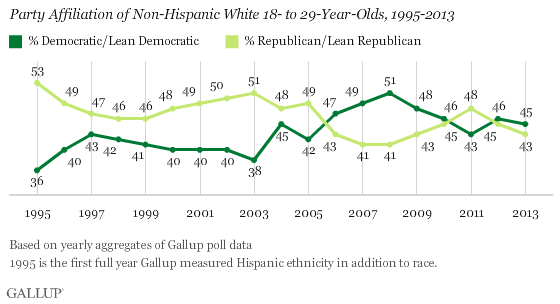PRINCETON, NJ -- Young adults -- those between the ages of 18 and 29 -- have typically aligned themselves with the Democratic Party, but they have become substantially more likely to do so since 2006.

From 1993 to 2003, 47% of 18- to 29-year-olds, on average, identified as Democrats or said they were independents but leaned to the Democratic Party, while 42% were Republicans or Republican leaners. That time span included two years in which young adults tilted Republican, 1994 and 1995, when Republicans won control of Congress. Since 2006, the average gap in favor of the Democratic Party among young adults has been 18 percentage points, 54% to 36%.
This Democratic movement among the young has come at a time when senior citizens have become more Republican. The broader U.S. population has shown more variability in its party preferences in recent years, shifting Democratic from 2005 to 2008, moving back toward the Republican Party from 2009 to 2011, and showing modest Democratic preferences in the last two years.
Younger Americans Now More Racially Diverse
A major reason young adults are increasingly likely to prefer the Democratic Party is that today's young adults are more racially and ethnically diverse than young adults of the past. U.S. political preferences are sharply divided by race, with nonwhite Americans of all ages overwhelmingly identifying as Democrats or leaning Democratic.
Gallup estimates that 54% of 18- to 29-year-olds are non-Hispanic white and 45% nonwhite, compared with 71% non-Hispanic white and 29% nonwhite in 1995, the first full year Gallup measured Hispanic ethnicity.
In 2013, 62% of nonwhite Americans between the ages of 18 and 29 were Democrats or Democratic leaners, while 25% were Republicans or Republican leaners. That 37-point Democratic advantage, though sizable, is slightly lower than the average 42-point advantage from 1995 through 2013.
But young adults are not more Democratic solely because they are more racially diverse. In recent years, young white adults, who previously aligned more with the Republican Party, have shifted Democratic. From 1995 to 2005, young whites consistently identified as or leaned Republican rather than Democratic, by an average of eight points. Since 2006, whites aged 18 to 29 have shown at least a slight Democratic preference in all but one year, with an average advantage of three points.

Young whites first shifted to a pro-Democratic position in 2006, perhaps because of frustration with George W. Bush and his policies. Barack Obama's presidential campaign also may have attracted younger whites, given the candidate's relative youth, particularly since Republicans nominated the much older John McCain as their presidential candidate. Young whites are not as high on the Democratic Party now as they were in 2008, but they remain more likely to prefer it to the Republican Party.
Implications
Recent decades have brought significant shifts in Americans' political allegiances, in the short term and the long term. While young adults have generally been more likely to align themselves with the Democratic Party than the Republican Party, they are now much more solidly Democratic than prior generations of young adults.
To a large extent, this reflects the increasing racial and ethnic diversity of the U.S. population, particularly among the youngest generations of Americans. And that growing diversity creates challenges for the Republican Party, given nonwhites' consistent and strong support for the Democratic Party. To some degree, Republicans have been able to offset the growing diversity and win elections by increasing their support among Americans aged 30 and older, particularly white senior citizens. But the GOP may find itself in an increasingly weak position against the Democrats unless it can broaden its appeal to younger and nonwhite Americans.
Survey Methods
Results are based on yearly aggregated data from multiple day Gallup telephone polls conducted between 1993 and 2013. Each yearly aggregate is based on a minimum of 18,000 interviews with adults age 18 and older.
For results based on the total sample of national adults in any given year, the margin of sampling error is ±1 percentage point at the 95% confidence level.
For results based on the total sample of Americans age 18 to 29, the margin of sampling error is ±3 percentage points at the 95% confidence level for 2007 and ±2 percentage points at the 95% confidence level for all other years.
